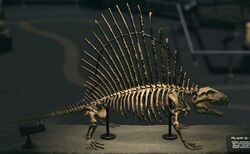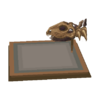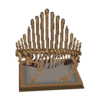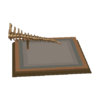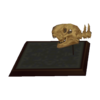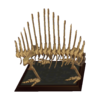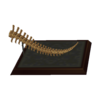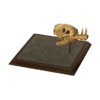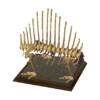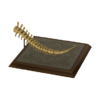Dimetrodon
The Dimetrodon is a multi-part fossil in the Animal Crossing series introduced in Animal Crossing: Wild World. In games prior to Animal Crossing: New Horizons it has three parts, and in New Horizons it has two parts.
At the museum[edit]
In Wild World[edit]
When donating to Blathers in Wild World, he will provide the following information about the Dimetrodon:
In City Folk[edit]
When donating to Blathers in City Folk, he will provide the following information about the Dimetrodon:
In New Leaf[edit]
After donating the final part of the fossil in New Leaf, its plaque in the museum will read:
In New Horizons[edit]
When the player donates to Blathers or selects "Tell me about this!" in New Horizons, he will provide the following information about the fossil:
The Dimetrodon can be found in the second room of the fossil exhibit in the museum.
As an item[edit]
In Wild World[edit]
| Dimetrodon skull | |
|---|---|
| Sell price | |
| Colors | Brown
Brown
|
| HRA genre | Old-school |
| Size | |
| Dimetrodon torso | |
|---|---|
| Sell price | |
| Colors | Brown
Brown
|
| HRA genre | Old-school |
| Size | |
| Dimetrodon tail | |
|---|---|
| Sell price | |
| Colors | Brown
Brown
|
| HRA genre | Old-school |
| Size | |
In City Folk[edit]
| Dimetrodon skull | |
|---|---|
| Sell price | |
| Colors | Brown
Brown
|
| HRA genre | Retro |
| Size | |
| Dimetrodon torso | |
|---|---|
| Sell price | |
| Colors | Brown
Brown
|
| HRA genre | Retro |
| Size | |
| Dimetrodon tail | |
|---|---|
| Sell price | |
| Colors | Brown
Brown
|
| HRA genre | Retro |
| Size | |
In New Leaf[edit]
| Dimetrodon skull | |
|---|---|
| Sell price | |
| Colors | Brown
Brown
|
| Style | Historical |
| HHA theme challenge | Quirky |
| Size | |
| Dimetrodon torso | |
|---|---|
| Sell price | |
| Colors | Brown
Brown
|
| Style | Historical |
| HHA theme challenge | Quirky |
| Size | |
| Dimetrodon tail | |
|---|---|
| Sell price | |
| Colors | Brown
Brown
|
| Style | Historical |
| HHA theme challenge | Quirky |
| Size | |
In New Horizons[edit]
| Dimetrodon skull | |
|---|---|
| Interactable | No |
| Sell price | |
| Colors | Brown
Brown
|
| Size | |
| Dimetrodon torso | |
|---|---|
| Interactable | No |
| Sell price | |
| Colors | Brown
Brown
|
| Size | |
Real-world information[edit]
| This section uses content from Wikipedia (en). The original article was at Dimetrodon. The list of authors can be seen in the page history. As with Nookipedia, the text of Wikipedia is available under the Creative Commons Attribution-ShareAlike 3.0 Unported license. |
Dimetrodon, meaning "two measures of teeth", is an extinct genus of non-mammalian synapsids that lived during the Cisuralian (Early Permian), around 295–272 million years ago (Ma). It is a member of the family Sphenacodontidae. The most prominent feature of Dimetrodon is the large neural spine sail on its back formed by elongated spines extending from the vertebrae. It walked on four legs and had a tall, curved skull with large teeth of different sizes set along the jaws. Most fossils have been found in the southwestern United States, the majority coming from a geological deposit called the Red Beds of Texas and Oklahoma. More recently, fossils have been found in Germany. Over a dozen species have been named since the genus was first described in 1878.
Dimetrodon is often mistaken for a dinosaur or as a contemporary of dinosaurs in popular culture, but it became extinct some 40 million years before the first appearance of dinosaurs. Reptile-like in appearance and physiology, Dimetrodon is nevertheless more closely related to mammals than to modern reptiles, though it is not a direct ancestor of mammals. Dimetrodon is assigned to the "non-mammalian synapsids", a group traditionally called "mammal-like reptiles". This groups Dimetrodon together with mammals in a clade (evolutionary group) called Synapsida, while placing dinosaurs, reptiles and birds in a separate clade, Sauropsida. Single openings in the skull behind each eye, known as temporal fenestrae, and other skull features distinguish Dimetrodon and mammals from most of the earliest sauropsids. It was a carnivore and had a fan to regulate body temperature.
More information on this topic is available at Wikipedia.
| Fossils | ||||||||||||||||||||||||
|---|---|---|---|---|---|---|---|---|---|---|---|---|---|---|---|---|---|---|---|---|---|---|---|---|
| ||||||||||||||||||||||||
